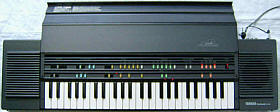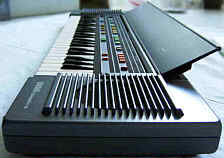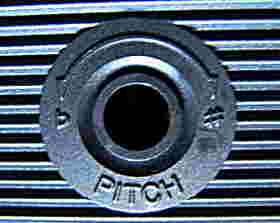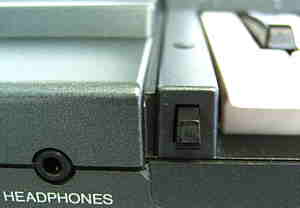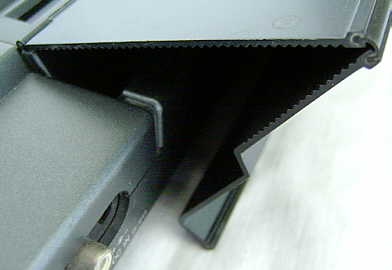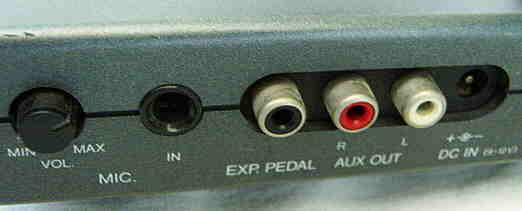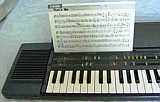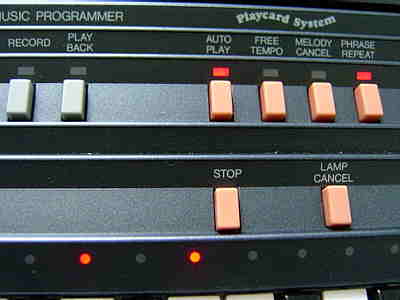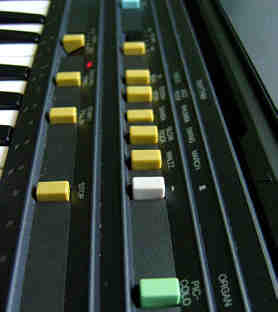 |
|
Playcard
keyboard with lid & key lighting |
 |
|
This Playcard System keyboard from 1984 was the successor of
the legendary Yamaha PC-100.
The sound engine of both instruments is very similar, but quite unique
with the PCS-500 is the suitcase- style case with the foldable keyboard
lid mechanism.
The main improvement to the PC-100 is the stereo chorus effect and the
larger speakers; the sound is warmer and makes more bass. Nice is that
a simple fingered accompaniment was added, which also accepts non- standard
chord, but unfortunately it lacks the lovely arpeggio of the PC-100.
Also some preset sounds are different, but due to the many similarities
I only describe here the differences to the latter.
different main features:
-
49 midsize keys
-
2 built-in speakers (reasonable quality with some bass, mono sound is routed
through a stereo chorus)
-
main voice polyphony only 7 notes (only 3 with accompaniment, 2 in duet
mode)
-
10 semi- OBS preset sound {organ, trumpet, saxophone, piano, guitar | piccolo,
violin, oboe, harpsichord, music box} selected by 5 locking buttons + bank
a switch button.
-
changed preset rhythm order (10 semi- OBS preset rhythms {disco, jazz rock,
rhumba, swing, march | 16 beat, bossanova, samba, slow rock, waltz} )
-
duet mode button switch
-
fill-in & stereo symphonic buttons
-
single finger & fingered accompaniment (manual organ chord with rhythm
off)
-
partly more complex accompaniment behaviour, but only 1 chord timbre
-
slide switches for rhythm & accompaniment volume (each 5 steps including
mute)
-
no arpeggio
-
sound generator resembles Yamaha PC-100,
but has less aliasing noise and sounds warmer.
-
simple sequencer (monophonic record/ playback with rhythm & accompaniment,
no edit)
-
tuning trimmer
-
built-in handle & keyboard lid
-
jacks for AC adapter, line out, headphone, microphone & analogue volume
pedal
 |
notes:
The Yamaha PCS-500 sounds warmer less harsh than the Yamaha
PC-100; apparently the waveforms have less aliasing noise, but
also the speakers are better. Like the latter, the sound generator itself
is mono, but when enabled, the "stereo symphonic" effect gently pans the
entire sound left and right with semi- random speed, which reminds to fluttering
tape mess although the sound is not really howling. An unusual detail is
that the red tempo LED cycles through 3 brightness steps and dark to indicate
the beats of the rhythm pattern. Quite unique is the foldable key lid of
aluminium, which is spring- loaded and can be used as a note stand when
folded back. But unlike this, the case itself is of varnished plastic and
its metallic paint scratches easily. It also neither protects the jacks
nor the fairly bulky speakers; the external carry case of the PC-100 or
Yamaha
PS-2 was a much more reasonable design. The PCS-500 was shipped
with these PlayCards.
(I haven't examined the hardware yet.)
The "clarinet" and "vibraphone" preset sounds of PC-100 were replaced
with "saxophone" and "music box". The "saxophone" has delayed vibrato.
The "music box" contains sustain and ignores the sustain button. Unlike
PC-100, the sustain button here adds rather a simulated reverb than sustain
to the sounds. The duet mode plays a duet of the main voice when in single
finger or fingered chord mode chord section keys are pressed.
The percussion employs the same electronic timbres like with PC-100,
but here they are likely filtered through capacitors and thus sound duller
and have much more bass. The manual chord timbre is less harsh than with
PC-100; it resembles rather an e-bass that has percussive attack but doesn't
decay. Unlike PC-100, there is only 1 fixed chord timbre that can not be
switched with the "variation" button. The accompaniment patterns partly
differ from the PC-100 and always employ "piano" for chords and "guitar"
for bass. In fingered chord mode the chord section notes do not repeat
within 1 octave (like a key split, but any notes are held until all chord
keys are released together), which with the automatic accompaniment has
the side effect that the octave of played chord differs from the same chords
played in single finger mode. Strange is also that while the single finger
accompaniment here has a fairly complex behaviour and e.g. inserts a walking
bass pattern at certain chord changes, the fingered accompaniment behaves
far simpler. It apparently does not recognize played chords at all but
only inserts the up to 4 notes of pressed keys into a given pattern (a
bit like the archaic Antonelli Star
2379). At least it permits to play any disharmonic note combinations
instead of establishment chords. The walking bass pattern is triggered
in this mode by pressing together 2 keys with 1 note distance (like 'C'
+ 'D').
The case style of the Yamaha PCS-500 somewhat resembles the big fullsize
keyboard Yamaha PS-6100 (FM sound, velocity sensitive, MIDI), which
had its control panel integrated into the keyboard lid.
| removal
of these screws voids warranty... |
|
|
 |

|
|
| |
back
|
|
